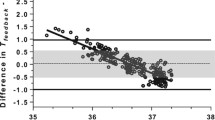Abstract
Objectives: (a) To investigate in a newborn animal model whether nasopharyngeal temperature is more closely related to epidural brain temperature than rectal temperature and (b) to investigate in human neonates whether measurement of nasopharyngeal temperature is dependent on the measurement site and other conditions. Design and setting: (a) Animal experiment in newborn piglets, at an institute for surgical research. (b) Prospective study in human neonates, at a neonatal intensive care unit of a tertiary care university hospital. Animals and patients: (a) Nineteen tracheostomized ventilated newborn piglets. (b) Twenty-two spontaneously breathing human newborns nursed either in an incubator or a cot. Measurements and results: (a) In the piglets nasopharyngeal temperature (Tnasoph) measured at the nose-ear distance, defined as distance from the inner brim of the nostril to the tragus and inner rim of the meatus accusticus, most closely reflected epidural temperature (Tepidur) at the epidural surface (r 2=0.89), followed by skin temperature at the temple, rectal temperature (Trectum) at 2 cm depth, and esophageal temperature (Tesoph) in the middle esophagus. Tnasoph did not significantly differ before and after tracheostomy. (b) In the newborns Tnasoph was significantly lower than Trectum. Measurements of Tnasoph at nose-ear distance within a feeding tube had a high precision and were unaffected by breathing or head turning. A nasopharyngeal probe was imaged by magnetic resonance imaging in four newborns of various body weight; its tip when inserted to a depth equal to nose-ear distance was anatomically closest to the brain base but separated from it by tissue layer 2.2 cm thick. Conclusions: Tnasoph measured at a position anatomically closest to the brain reflects epidural brain temperature more closely than Trectum. When measured at nose-ear distance it is unaffected by breathing or head turning. Measuring Tnasoph within a feeding tube and standardizing the measuring position is crucial for its use as brain temperature analogue.
Similar content being viewed by others
Author information
Authors and Affiliations
Additional information
Final revision received: 13 September 2000
Electronic Publication
Rights and permissions
About this article
Cite this article
Ko, HK., Flemmer, A., Haberl, C. et al. Methodological investigation of measuring nasopharyngeal temperature as noninvasive brain temperature analogue in the neonate. Intensive Care Med 27, 736–742 (2001). https://doi.org/10.1007/s001340000829
Received:
Accepted:
Published:
Issue Date:
DOI: https://doi.org/10.1007/s001340000829




